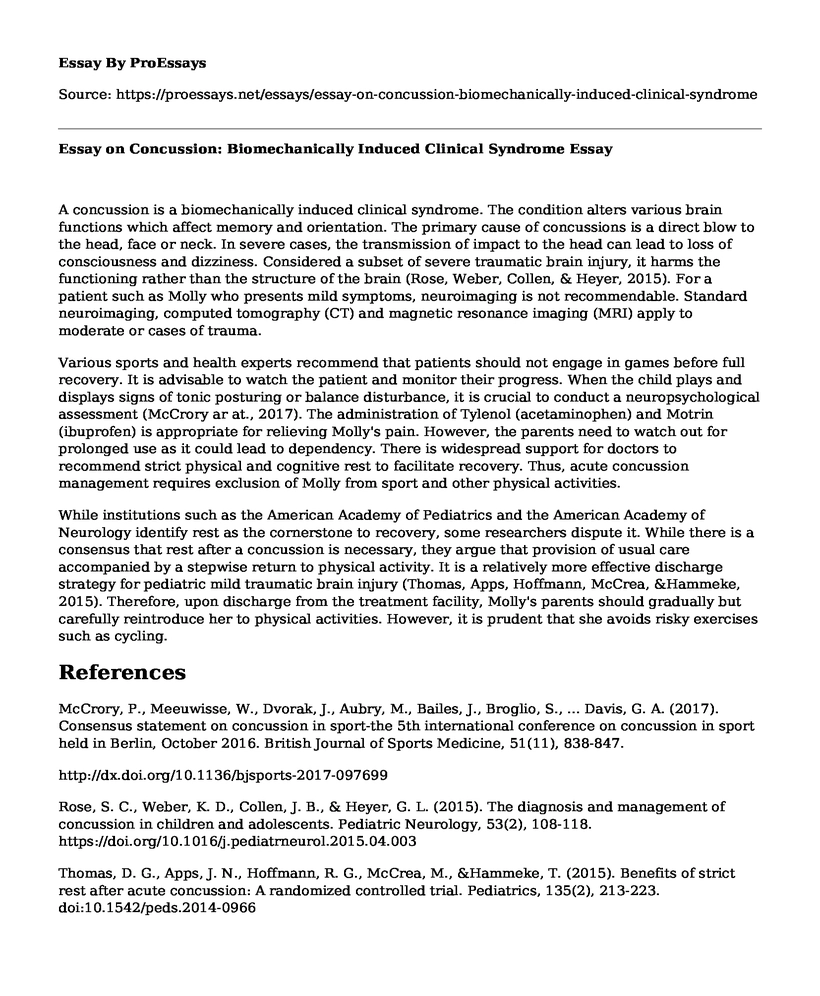A concussion is a biomechanically induced clinical syndrome. The condition alters various brain functions which affect memory and orientation. The primary cause of concussions is a direct blow to the head, face or neck. In severe cases, the transmission of impact to the head can lead to loss of consciousness and dizziness. Considered a subset of severe traumatic brain injury, it harms the functioning rather than the structure of the brain (Rose, Weber, Collen, & Heyer, 2015). For a patient such as Molly who presents mild symptoms, neuroimaging is not recommendable. Standard neuroimaging, computed tomography (CT) and magnetic resonance imaging (MRI) apply to moderate or cases of trauma.
Various sports and health experts recommend that patients should not engage in games before full recovery. It is advisable to watch the patient and monitor their progress. When the child plays and displays signs of tonic posturing or balance disturbance, it is crucial to conduct a neuropsychological assessment (McCrory ar at., 2017). The administration of Tylenol (acetaminophen) and Motrin (ibuprofen) is appropriate for relieving Molly's pain. However, the parents need to watch out for prolonged use as it could lead to dependency. There is widespread support for doctors to recommend strict physical and cognitive rest to facilitate recovery. Thus, acute concussion management requires exclusion of Molly from sport and other physical activities.
While institutions such as the American Academy of Pediatrics and the American Academy of Neurology identify rest as the cornerstone to recovery, some researchers dispute it. While there is a consensus that rest after a concussion is necessary, they argue that provision of usual care accompanied by a stepwise return to physical activity. It is a relatively more effective discharge strategy for pediatric mild traumatic brain injury (Thomas, Apps, Hoffmann, McCrea, &Hammeke, 2015). Therefore, upon discharge from the treatment facility, Molly's parents should gradually but carefully reintroduce her to physical activities. However, it is prudent that she avoids risky exercises such as cycling.
References
McCrory, P., Meeuwisse, W., Dvorak, J., Aubry, M., Bailes, J., Broglio, S., ... Davis, G. A. (2017). Consensus statement on concussion in sport-the 5th international conference on concussion in sport held in Berlin, October 2016. British Journal of Sports Medicine, 51(11), 838-847.
http://dx.doi.org/10.1136/bjsports-2017-097699
Rose, S. C., Weber, K. D., Collen, J. B., & Heyer, G. L. (2015). The diagnosis and management of concussion in children and adolescents. Pediatric Neurology, 53(2), 108-118. https://doi.org/10.1016/j.pediatrneurol.2015.04.003
Thomas, D. G., Apps, J. N., Hoffmann, R. G., McCrea, M., &Hammeke, T. (2015). Benefits of strict rest after acute concussion: A randomized controlled trial. Pediatrics, 135(2), 213-223. doi:10.1542/peds.2014-0966
Cite this page
Essay on Concussion: Biomechanically Induced Clinical Syndrome. (2023, Jan 02). Retrieved from https://proessays.net/essays/essay-on-concussion-biomechanically-induced-clinical-syndrome
If you are the original author of this essay and no longer wish to have it published on the ProEssays website, please click below to request its removal:
- Image of Nursing Essay Example
- Overview of Selected Evidenced-Based Practice Project Paper Example
- Essay Sample on Electronic Medical Records
- Pathophysiology of Thalassemia Paper Example
- Paper Example on Treating Hypertension & Heart Failure With Trandolapril
- Essay on Experience Genitourinary Syndrome of Menopause: Symptoms & Assessment
- Planned Parenthood of Southeast Pennsylvania v Casey







